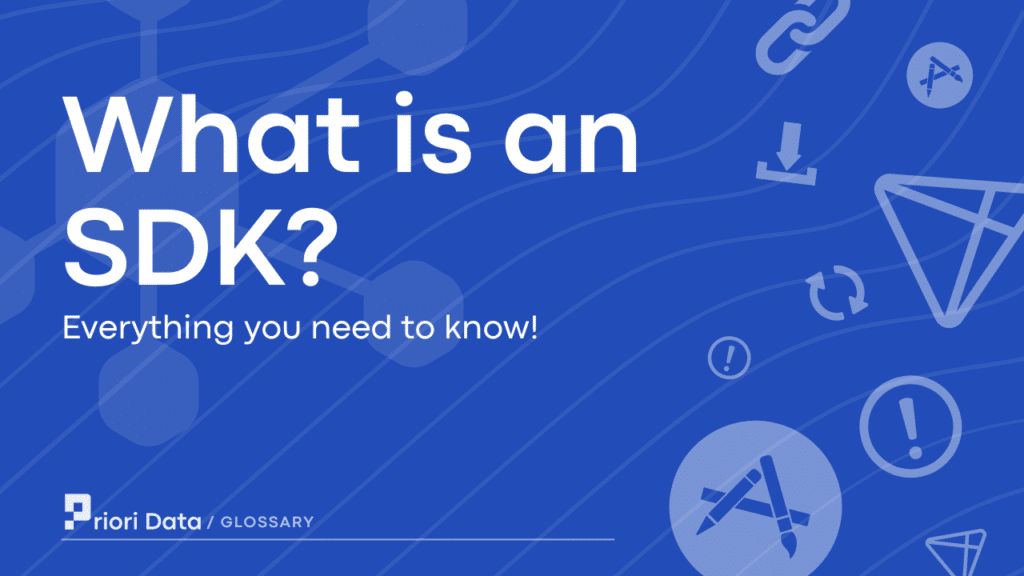Software Development Kit or SDK is a set of tools and programs developers need to build applications. It is an essential toolkit for developing and integrating an app for specific platforms.
Usually, hardware and software vendors provide software development kits to the developers. It helps them integrate the app with the vendor’s services.

What are the major components of SDK?
Working on an application becomes hassle-free when developers are equipped with every essential component required for developing and maintaining the app. Usually, SDK includes the following components:
Libraries
Developers need reusable pieces of code to avoid writing everything from scratch. Library gives them access to code collection. These reusable and packaged pieces of code help developers perform specific functions.
APIs
To perform common programming tasks, developers require predefined pieces of code, and the Application Programming Interface (API) is all about it.
Integrated development environments (IDEs)
IDEs help developers with visual editing the graphical elements such as buttons and boxes. Basically, it helps with the design and layouts. IDEs play a major role in mobile software app development toolkits.
Testing tools
Identifying errors is one of the major practices in the app development process, and testing tool helps in the same. It includes debugging tools and help in various stages of app development.
Documentation
The presence of tutorials and instructions helps developers in every stage of app development, and documentation talks all about them.
How to use an SDK?
Different SDKs are required for developing applications for different mobile operating systems. For instance, iOS SDK will help the developer build an iOS app and Android SDK for android apps. For developing wireless apps, Nordic SDK is required.
Apart from these, Microsoft Windows SDK, Google Cloud SDK, and Java Development Kit are some other popular SDKs.
Following are the three major steps typically involved in using SDKs-
- A developer purchases a platform-specific SDK, downloads, and installs it.
- The next step involves development within an Integrated Development Environment (IDE). The developer can also use the APIs in the kit to create new apps.
- The other components, like documentation, instructions, testing tools, etc., are then used by the developer to accelerate the different phases of app development.
What factors contribute to making a good SDK?
Developers often face a dilemma while choosing the right SDK. It is mainly because SDK providers always offer lucrative and new commercial and open-source SDKs.
Therefore, while selecting SDK, you need to take a sneak peek at the specific features you are looking for as well as the price tag.
Apart from these, the other essential factors that you can take into account include the following:
- User-friendly interface
- High functionality to add value to the applications
- Clear instructions and well documented on how the code works
- Code samples
- Fast and easy integration process
- Upkeep with the growing requirements of a business
- Should not impact battery life
- Ensure minimum data consumption
- Follow and adhere to the recent security guidelines
What are the advantages of SDKs?
App developers face multiple issues while developing an application. It is when SDK comes to the rescue. The biggest advantage is SDK gives access to low-level APIs that are not available otherwise. It eases the developer’s work of integrating an existing app into your platform.
The testing tool in SDK helps find and fix errors before porting the application. Likewise, documentation assists while debugging. Thus, SDK makes developers work fast and easy.
The key benefits of SDKs can be summarized as follows:
- Shorter development cycle
- Faster deployment
- Easier integration
- Enhanced functionality
- Risk mitigation
- Cost saving
- Saves time
Apart from these, SDKs also help enhance the functionality of an application. It allows developers to create and integrate new tools for easier processing. Also, an app’s brand credibility increases when the SDK toolkit supports it. It makes the app less prone to crashes and, thus, more reliable.
Are there any pitfalls in an SDK toolkit?
As SDKs allow easy integration, developers often start incorporating multiple ad networks and analytics services. It may slow down the performance of the app. At the same time, it may make the troubleshooting process complex.
Therefore, whenever the provider releases a new version, SDK should be updated. It ensures getting continued support for better functionality of the app. It also makes the debugging process fast and easy.
Some common pitfalls in an SDK toolkit are:
- Not updated
- Improper documentation
- Does not support the certain programming language
- Requires permission for third-party libraries
- Does not support certain services or functionality
- Licensing issues
FAQs
Q1. What does Software Development Kit do?
Ans: Software Development Kit (SDK) comprises a set of tools and programs that help developers build an application. It makes the app development and integration process fast and easy.
Q2. What is the difference between API and SDK?
Ans: An application Programming Interface (API) is a set of libraries that allow communication between apps or software. SDK is an all-purpose kit that offers programs and tools to create an entirely new app. While API is a tool, SDK is a toolkit with API as a major component.
Q3. What languages are used in SDK?
Ans: Many SDKs support programming languages like C#, Python, Java, PHP, Ruby, Go, etc., and are called server-side SDKs. It makes them an integral part of an overall developer support strategy.






